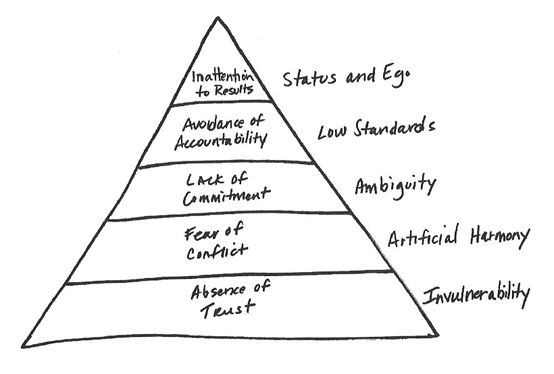Recently in my Senior Design class the instructor recommended that we all read the book The Five Dysfunctions of a Team by Patrick Lencioni. The book is a business story centered on Kathryn, a new CEO to a failing high-tech company, DecisionTech. Throughout the story Kathryn works her way to the root causes of the executive team’s failures that made me think about lean philosophy. Although the book never specifically refers to lean, many of the principles presented are similar.
Although DecisionTech’s product was great, and there was plenty of money from investors, for some reason the company was failing miserably. For this reason the Board of Directors hires Kathryn to be the new CEO. Kathryn has previous executive experience in the automotive industry (there is a reference to a joint US-Japanese automotive plant in California), and she is older than everybody else on the executive team. For the first two weeks after being hired Kathryn has the previous CEO (who still works for the company) run the business as usual for Kathryn to observe. Kathryn walks around talking to employees at all levels and attends as many staff meetings as possible. When I read this I immediately thought about Gemba Walks and the importance of going to see problems at their physical location.
The book goes on to discuss the five dysfunctions of a team, which are:
- Absence of trust (shown by a individuals thinking they are invulnerable)
- Fear of conflict (shown by a team creating artificial harmony)
- Lack of commitment (shown by ambiguity in team functions)
- Avoidance of accountability (shown through holding low team standards)
- Inattention to results (shown by individuals focusing on status and their ego more than the team’s goals)

All of the dysfunctions tie in with each other, and although none are explicitly lean they can all be related to some aspect of lean philosophy. “Respect for people” is one of the cornerstones of lean that encompasses all five of the dysfunctions. For instance, a team that respects its own people would have no problem with healthy conflict and problem solving. Kaizen events may have intense discussions during root cause analysis or four-step problem solving, but as long as the discussion is “hard on the process, easy on the people” a team can show each other respect.
Overall the book was a quick read that provides a new perspective on teamwork. Patrick Lencioni does not specifically call out any lean principles or tools, but many of the same thought processes are evident throughout the storyline. Finally, the storytelling method focusing on Kathryn keeps the book fast-paced and lively resulting in an enjoyable reading experience.